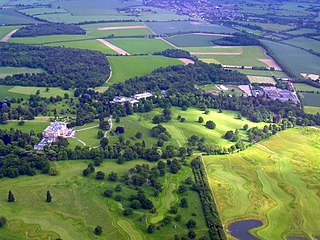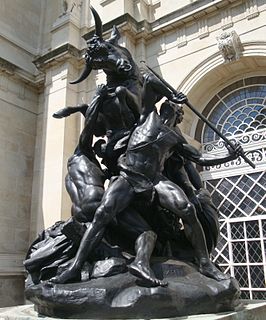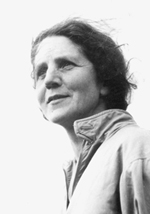
Rothamsted Research, previously known as the Rothamsted Experimental Station and then the Institute of Arable Crops Research, is one of the oldest agricultural research institutions in the world, having been founded in 1843. It is located at Harpenden in the English county of Hertfordshire and is a registered charity under English law.
Frank Yates FRS was one of the pioneers of 20th century statistics.

Harpenden is a town and civil parish in the City and District of St Albans in the county of Hertfordshire, England. The population of the built-up area was 30,240 in the 2011 census, whilst the population of the civil parish was 29,448. Harpenden is a commuter town, with a direct rail connection through Central London and property prices well over triple the national average.

Sir John Bennet Lawes, 1st Baronet, FRS was an English entrepreneur and agricultural scientist. He founded an experimental farm at his home at Rothamsted Manor that eventually became Rothamsted Research, where he developed a superphosphate that would mark the beginnings of the chemical fertilizer industry.

Aldermaston Court is a country house and private park built in the Victorian era for Daniel Higford Davall Burr with incorporations from a Stuart house. It is south-east of the village nucleus of Aldermaston in the English county of Berkshire. The predecessor manor house became a mansion from the wealth of its land and from assistance to Charles I during the English Civil War under ownership of the Forster baronets of Aldermaston after which the estate has alternated between the names Aldermaston Park and Aldermaston Manor.

Luton Hoo is an English country house and estate near Luton in Bedfordshire and Harpenden in Hertfordshire. Most of the estate lies within the civil parish of Hyde, Bedfordshire. The Saxon word Hoo means the spur of a hill, and is more commonly associated with East Anglia.
An agricultural experiment station (AES) or agricultural research station (ARS) is a scientific research center that investigates difficulties and potential improvements to food production and agribusiness. Experiment station scientists work with farmers, ranchers, suppliers, processors, and others involved in food production and agriculture.

Elliott Brothers (London) Ltd was an early computer company of the 1950s–60s in the United Kingdom. It traced its descent from a firm of instrument makers founded by William Elliott in London around 1804. The research laboratories were originally set up in 1946 at Borehamwood and the first Elliott 152 computer appeared in 1950.
Norman Wingate (Bill) Pirie FRS, was a British biochemist and virologist who, along with Frederick Bawden, discovered that a virus can be crystallized by isolating tomato bushy stunt virus in 1936. This was an important milestone in understanding DNA and RNA.

The Central Science Laboratory (CSL) was an executive agency of the UK government branch, the Department for Environment, Food and Rural Affairs (DEFRA). It is now part of the Food and Environment Research Agency, which is in turn part of DEFRA.

Roundwood Park School is a mixed, 11-18 secondary school with academy status situated in Harpenden, Hertfordshire, UK. Opened in 1956, it currently has around 1200 pupils, most of whom live in the local area and surrounding villages At the beginning of 2011, Roundwood formed a charitable trust. St George's School joined the trust in 2013 and it is now known as "The Harpenden Secondary Schools Trust".
Harpenden Rugby Football Club is a rugby club based in Harpenden. They play in London 1 North - a league at tier 6 of the English rugby union system - following their promotion from London 2 North West via the playoffs at the end of the 2018–19 season.

Sir John Lawes School is a mixed state secondary school with academy status in Harpenden, United Kingdom. The school has close links to two other local secondary schools, Roundwood Park School and St George's School, and to the neighbouring Manland Primary School, and is active in the community and abroad.

Rothamsted Park is a 56-acre (230,000 m2) public park in Harpenden, Hertfordshire.

Sir Edward John Russell was a British soil chemist, agriculture scientist, and director of Rothamsted Experimental Station from 1912 to 1943. He was responsible for hiring R. A. Fisher for statistical research at Rothamsted. Driven by concerns over a lack of international information exchange about agriculture, he initiated the Imperial Agricultural Bureaux, which later became the Commonwealth Agricultural Bureaux.
Sir John Wittewrong, 1st Baronet was an English parliamentarian colonel and squire of Rothamsted Manor.

Sir Charles Bennet Lawes-Wittewronge, 2nd Baronet was an English rower, athlete and sculptor. He exhibited twelve works at the Royal Academy.
Colin Gasking Butler OBE FRS was a British entomologist who first isolated the pheromone, known as "queen substance", which attracts drones to queen bees.

Mary Dilys Glynne was a British plant pathologist and mountaineer.
Robert Warington, Jr. was an English agricultural chemist, known for his research and publications on the chemistry of phosphates and nitrates in agricultural soils.















